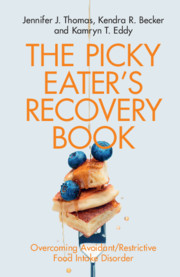Book contents
- The Picky Eater’s Recovery Book
- The Picky Eater’s Recovery Book
- Copyright page
- Dedication
- Table of Contents
- Reviews
- Preface
- Acknowledgments
- Section I All About ARFID
- Section II Getting Started (Stages 1 and 2)
- 3 How Does ARFID Work?
- 4 Regular Eating and Early Change
- 5 Identifying What Else Needs to Change
- Section III Tackling What Keeps Your ARFID Going (Stage 3)
- Section IV Moving Forward (Stage 4)
- References
- Index
3 - How Does ARFID Work?
from Section II - Getting Started (Stages 1 and 2)
Published online by Cambridge University Press: 03 September 2021
- The Picky Eater’s Recovery Book
- The Picky Eater’s Recovery Book
- Copyright page
- Dedication
- Table of Contents
- Reviews
- Preface
- Acknowledgments
- Section I All About ARFID
- Section II Getting Started (Stages 1 and 2)
- 3 How Does ARFID Work?
- 4 Regular Eating and Early Change
- 5 Identifying What Else Needs to Change
- Section III Tackling What Keeps Your ARFID Going (Stage 3)
- Section IV Moving Forward (Stage 4)
- References
- Index
Summary
This chapter provides a basic introduction to the relationship between thoughts, feelings, and behaviors, and introduces our cognitive-behavioral model of ARFID.Wereturn to the case examples from Chapter 1 to illustrate a cognitive-behavioral understanding of sensory sensitivity, fear of aversive consequences, and lack of interest in eating or food.
Keywords
- Type
- Chapter
- Information
- The Picky Eater's Recovery BookOvercoming Avoidant/Restrictive Food Intake Disorder, pp. 37 - 53Publisher: Cambridge University PressPrint publication year: 2021

